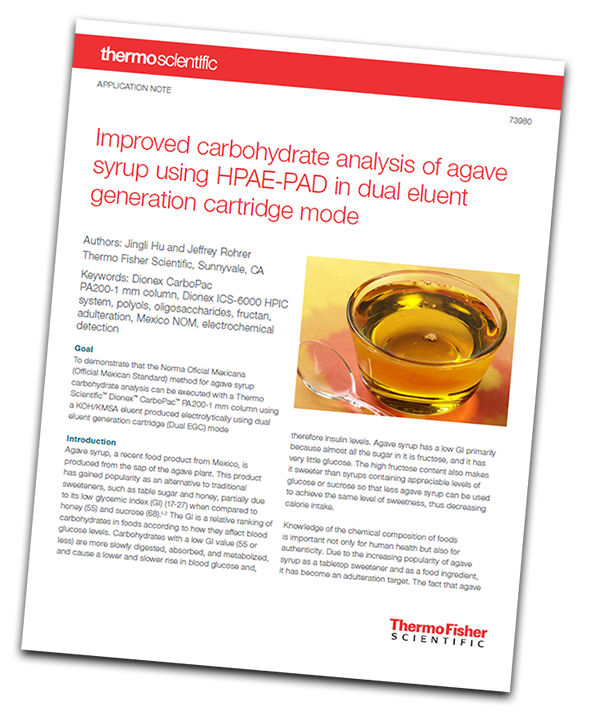This application note demonstrates an improved method showing how Norma Oficial Mexicana (NOM) for agave syrup carbohydrate analysis is executed with a Thermo Scientific Dionex CarboPac PA1-1 mm column using HPAE-PAD in EGC mode.
 Goal
Goal
To demonstrate that the Norma Oficial Mexicana (Official Mexican Standard) method for agave syrup carbohydrate analysis can be executed with a Thermo Scientific™ Dionex™ CarboPac™ PA1-1mm column using KOH/KMSA eluent produced electrolytically using Dual Eluent Generation Cartridge (Dual EGC) mode.
Introduction
Agave syrup, a recent food product from Mexico, is produced from the sap of the agave plant. This product has gained popularity as an alternative to traditional sweeteners, such as table sugar and honey, partially due
to its low glycemic index (GI) (17-27) when compared to honey (55) and sucrose (68). The GI is a relative ranking of carbohydrates in foods according to how they affect blood glucose levels. Carbohydrates with a low GI value (55 or less) are more slowly digested, absorbed, and metabolized, and cause a lower and slower rise in blood glucose and, therefore insulin levels. Agave syrup has a low GI primarily because almost all the sugar in it is fructose, and it has very little glucose. The high fructose content also makes it sweeter than syrups containing appreciable levels of glucose or sucrose so that less agave syrup can be used to achieve the same level of sweetness, thus decreasing calorie intake.
Experimental
Full details of the experimental conditions can be found by downloading the application note.
Results and Discussion
Separation
The Dionex CarboPac PA1 column is a general purpose column for the separation of mono, di, and some oligosaccharides by high pH anion-exchange chromatography, coupled with PAD. The application note demonstrates a separation of main sugars (fructose, glucose, and sucrose), polyols (sorbitol, mannitol, inositol), and 5-hydroxymethylfurfural (HMF). Inositol, sorbitol, mannitol, HMF, fructose, and glucose were well resolved. The resolutions between all the components were >2.0.
Conclusion
This application note demonstrates that the NOM method for agave syrup carbohydrate analysis could be successfully executed with a Dionex CarboPac PA200-1 mm column using HPAE-PAD in EGC mode. The separation, linearity, reproducibility, and sensitivity were excellent. This method is reliable and can be used for major sugars, polyols, and HMF determination in agave syrup. The carbohydrate profile after enzymatic hydrolysis can be used for adulteration detection. Comparison with a traditional HPAE-PAD separation of agave syrup using sodium hydroxide/sodium acetate eluents showed that the Dual EGC method delivers similar resolution of agave carbohydrates but simplifies operation (no eluent preparation) and improves retention time precision.
